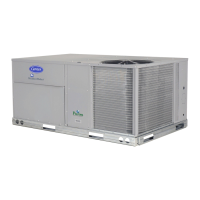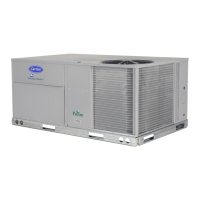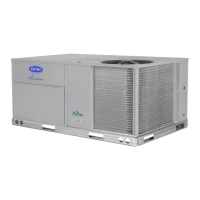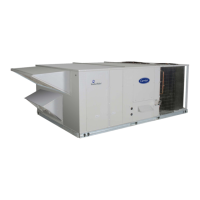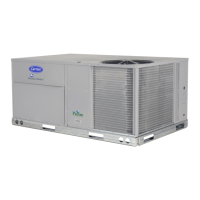46
Power Up
After the W7220 module is mounted and wired, apply power.
Initial Menu Display
On initial start up, Honeywell displays on the first line and Econo-
mizer W7220 on the second line. After a brief pause, the revision
of the software appears on the first line and the second line will be
blank.
Power Loss (Outage or Brownout)
All setpoints and advanced settings are restored after any power
loss or interruption.
NOTE: All settings are stored in non-volatile flash memory.
Status
Use the Status menu (see Table 12) to check the parameter values
for the various devices and sensors configured.
NOTE: See “Interface Overview” on page 35. for information
about menu navigation and use of the keypad.
Checkout Tests
Use the Checkout menu (in Table 12) to test the damper operation
and any configured outputs. Only items that are configured are
shown in the Checkout menu.
NOTE: See “Interface Overview” on page 35 for information
about menu navigation and use of the keypad.
To perform a Checkout test:
1. Scroll to the desired test in the Checkout menu using the ▲
and ▼ buttons.
2. Press the button to select the item.
3. RUN? appears.
4. Press the button to start the test.
5. The unit pauses and then displays IN PROGRESS.
6. When the test is complete, DONE appears.
7. When all desired parameters have been tested, press the
(Menu Up) button to end the test.
The Checkout tests can all be performed at the time of installation
or at any time during the operation of the system as a test that the
system is operable.
TROUBLESHOOTING
Alarms
The economizer module provides alarm messages that display on
the 2-line LCD.
NOTE: Upon power up, the module waits 60 minutes before
checking for alarms. This allows time for all the configured devic-
es (e.g. sensors, actuator) to become operational. The exception is
the SAT sensor which will alarm immediately.
If one or more alarms are present and there has been no keypad ac-
tivity for at least 5 minutes, the Alarms menu displays and cycles
through the active alarms.
You can also navigate to the Alarms menu at any time.
Clearing Alarms
Once the alarm has been identified and the cause has been re-
moved (e.g. replaced faulty sensor). the alarm can be cleared from
the display.
To clear an alarm, perform the following:
1. Navigate to the desired alarm.
2. Press the button.
3. ERASE? displays.
4. Press the button.
5. ALARM ERASED displays.
6. Press the (Menu up/Exit) button to complete the action
and return to the previous menu.
NOTE: If the alarm still exists after you clear it, it is redisplayed
within 5 seconds.
PremierLink™ Control
For details on operating units equipped with the factory-installed
PremierLink controller option, refer to the PremierLink Retrofit
Rooftop Controller Version 3.x Installation, Start-Up, and Config-
uration Instructions manual.
For wiring the PremierLink controller, see Fig. 52. For wiring the
controller to a unit equipped with a Humidi-MiZer
®
system, see
Fig. 53.
RTU Open Control System
For details on operating units equipped with the factory-installed
RTU Open controller, refer to the “Factory-Installed RTU Open
Multi-Protocol Controller Control, Start-Up, Operation and Trou-
bleshooting” manual.
For typical RTU Open controller wiring, see Fig. 54. For wiring
the controller to a unit equipped with a Humidi-MiZer
®
system,
see Fig. 55.
Wiring Diagrams
See Fig. 56-63 for unit wiring diagrams.
WARNING
ELECTRICAL SHOCK HAZARD
Failure to follow this warning could result in personal injury,
property damage, or death.
Before performing service or maintenance operations on unit,
always turn off main power switch to unit and install lock(s)
and lockout tag(s). Unit may have more than one power
switch. Ensure electrical service to rooftop unit agrees with
voltage and amperage listed on the unit rating plate.
If any wiring changes are required, first be sure to remove
power from the economizer module before starting work. Pay
particular attention to verifying the power connection (24 vac).
CAUTION
EQUIPMENT DAMAGE HAZARD
Failure to follow this caution may result in equipment damage.
Be sure to allow enough time for compressor start-up and shut-
down between checkout tests so that you do not short-cycle the
compressors.

